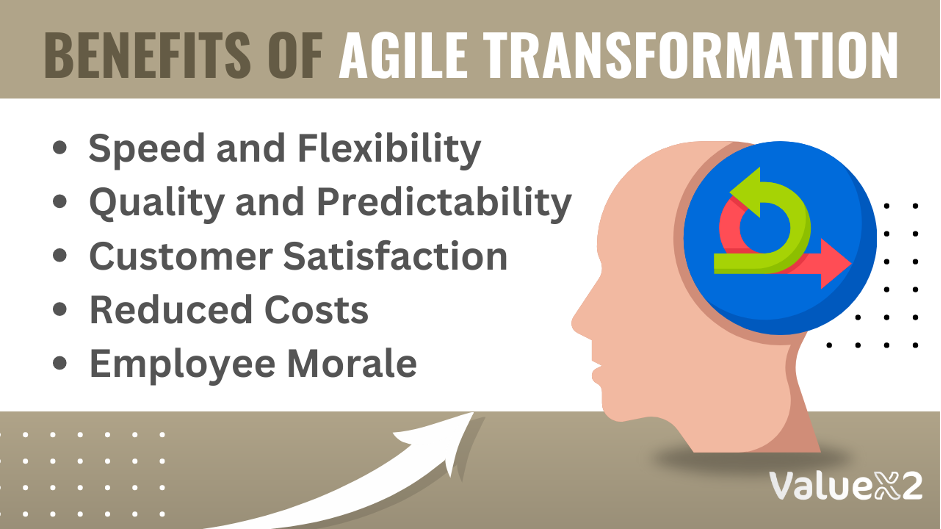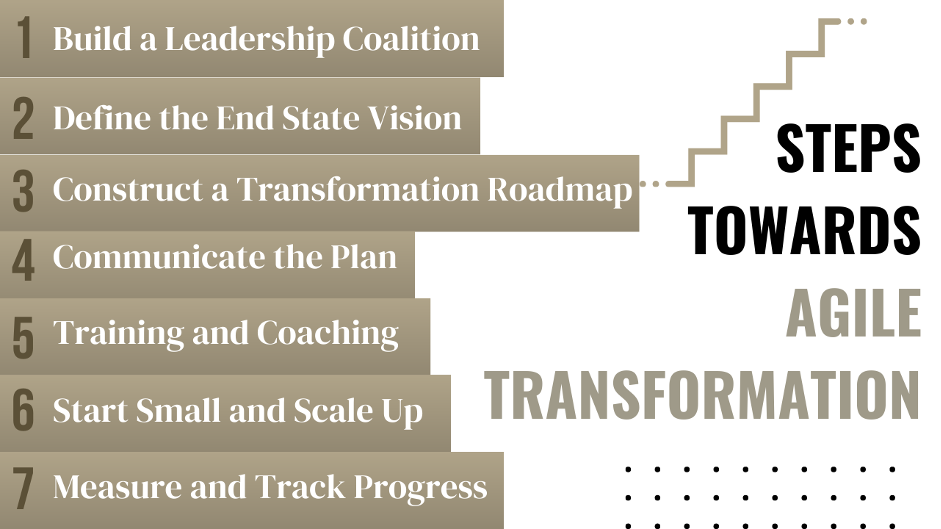Learn about the key steps and challenges faced to achieve agile transformation and know the benefits of agile transformation.
In the world of business and project management, there has been the inclusion of agile principles and practices, which have the upper hand over traditional methods. Using agile methodologies in the organization has made work more accessible in several ways.
In this article, we shall engage you on the steps taken towards transforming your organization into an agile one from a traditional setup. We will also learn about the difficulties encountered, how to get through them, and the benefits of this transition. But, before diving into details, first, let us understand what is agile and its transformation.
What is Agile Transformation?
Firstly, what is Agile? Agile is a project management methodology mainly involved with iterative development, ongoing feedback, and teamwork. Agile teams divide large projects into smaller, more manageable units called sprints, and after each sprint, they produce usable software. Crews can respond to change more swiftly and provide consumers with value more quickly.
For organizations, agile transformation is akin to a superhero makeover. To adopt an agile approach to software development, firms must change the way they operate and think. This entails using agile principles like iterative development, continuous delivery, and customer collaboration.
Why Agile Transformation Matters

Now that you have a certain level of understanding of Agile transformation and know it is not just a catchword, you may want to know its significance. It brings a swarm of advantages to an organization:
- Speed and Flexibility: The Agile teams can deliver projects faster since they work in short sprint cycles. They receive feedback more regularly as a result, which enables them to make the required modifications throughout the project. Like superhumans on a mission, organizations are capable of swift response and changing adaptation.
- Quality and Predictability: Organizations can deliver high-quality results and predict project outcomes more effectively with agile practices. With this, agile teams can deliver high-quality projects. This is because, unlike the Traditional teams, they can now get feedback during processing and modify the affected areas preventing them from becoming problems later on.
- Customer Satisfaction: Agile organizations collaborate with customers, ensuring their needs are met like superheroes coming to the rescue. How do they collaborate? The major factor is the feedback they get from customers and clients during the development process. This lets them know whether the product meets the customers’ wants and needs.
- Reduced Costs: Agile practices lead to more efficient processes; this ensures they deliver products quickly and of better quality. Since they make adjustments during the development, they easily save on costs for repairs and rework. This ultimately saves organizations from financial crises.
- Employee Morale: Agile transformation empowers employees by allowing them to be more creative and giving them more autonomy, igniting their enthusiasm like superheroes ready to conquer the world. They should also be encouraged to be risk-takers and practice more experiments.
Essential Steps Towards Agile Transformation

The track headed for agile transformation requires a tactical approach. This is to aid you in making the steady changes towards your success as an Agilist or an Agile organization:
- Build a Leadership Coalition
Assemble a team of influential leaders dedicated to the transformation. They will establish the direction, direct the procedure, and give the rest of the company vital support. You require personal leadership abilities. There are many courses in Agile leadership, like the Leading SAFe® (SA) Certification Course. This course gives a hands-on education that will guide you through the Agile Transformation process of an organization.
- Define the End State Vision
Following on from setting up a leadership team is to create a clear vision of what the transformed organization should look like. This vision should include the anticipated state of the organization upon completion, including the desired culture, practices, and outcomes.
- Construct a Transformation Roadmap
Design a roadmap that outlines the steps needed to achieve the end-state vision. This roadmap should be flexible and adaptable to cater for expected plot twists, as agile transformations are often full of surprises.
- Communicate the Plan
Once the roadmap to transformation is set, communicate the transformation plans extensively throughout the organization. The communication should be concise, clear, and done frequently throughout the organization. Address any questions that may be asked by the employees on transformation. This is essential to build understanding and generate support.
- Training and Coaching
Equip employees with the necessary training and coaching to be agile superheroes. Knowledge of agile methodologies, frameworks, principles and practices, tools and technologies are essential. There are a lot of certification courses on this; hurry up and get certified!
- Start Small and Scale Up
Begin with a pilot project to test the waters. It’s like a superhero trying their powers before facing the ultimate challenge. This will help the organization to learn to make mistakes early before heading for further projects.
- Measure and Track Progress
Keep a watchful eye on progress throughout the transformation. In this manner, you may determine what is effective and what requires modification. You will also learn about the challenges faced and how to overcome them.
Even superheroes face challenges, and agile transformation is no exception. Below is a small list of challenges an organization might face during agile transformation and how to overcome them:
- Resistance to Change: Some employees are resistant to change, especially if they have adopted traditional methods. Conquer resistance by highlighting the benefits of agile practices and inspiring enthusiasm for transformation.
- Lack of Understanding: They may need help understanding agile principles and practices, making implementing Agility in an organization difficult. Educate employees about agile principles and practices, turning them into agile aficionados.
- Resource Constraints: For an organization to have a successful agile transformation, they may require additional resources; training, coaching and tools. This may be difficult for organizations that need more resources to undergo agile transformation. Superheroes require help, and so does agile transformation. Ensure you have the necessary support and funding.
- Executive Support: Executive support is critical for an organization’s transformation. With this support, it will be easier for the organization to implement agile. Like a superhero team-up, secure permission from top-level executives to ensure the transformation’s success.
Conclusion
Agile transformation is a task that may be difficult to conquer for some, but it is worthwhile. Organizations may unleash the full potential of Agility and soar to new heights like agile champions by adhering to the steps and conquering obstacles.

Sagar is an HR Agile Coach & Business Agility Consultant with over a decade of experience in HR functions at small and large multinational corporations. He has been running an HR consulting firm for the last few years, focusing on leveraging agile methods to increase business efficiency.
Sagar is an authorized instructor for ICAgile Agility in HR (ICP-AHR) and Business Agility Foundations (ICP – BAF) training courses. He has considerable experience in coaching and training on applying agile practices for his clients, primarily HR departments. He also provides consulting for HR for Agile and Agile for HR transformation to corporates.







